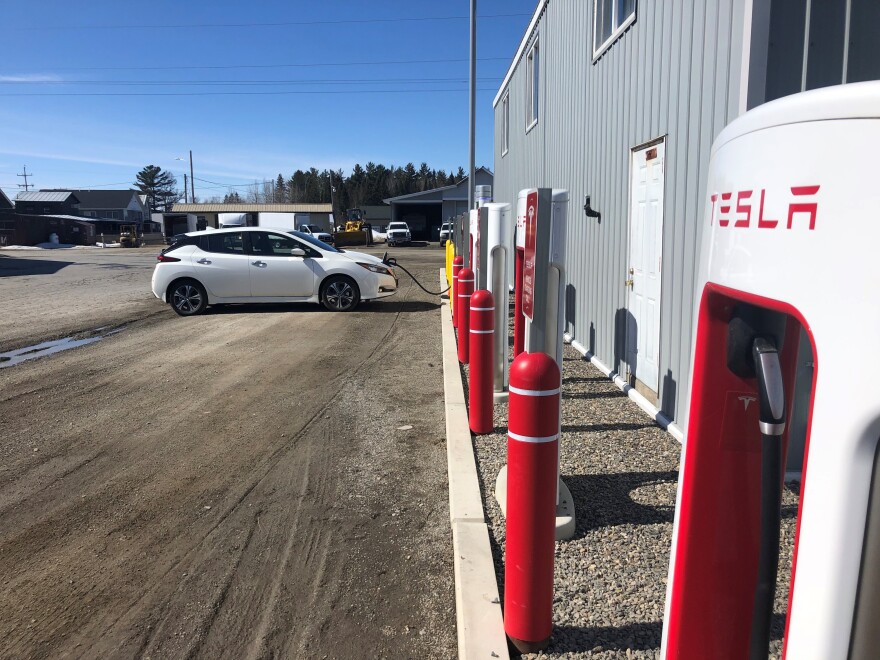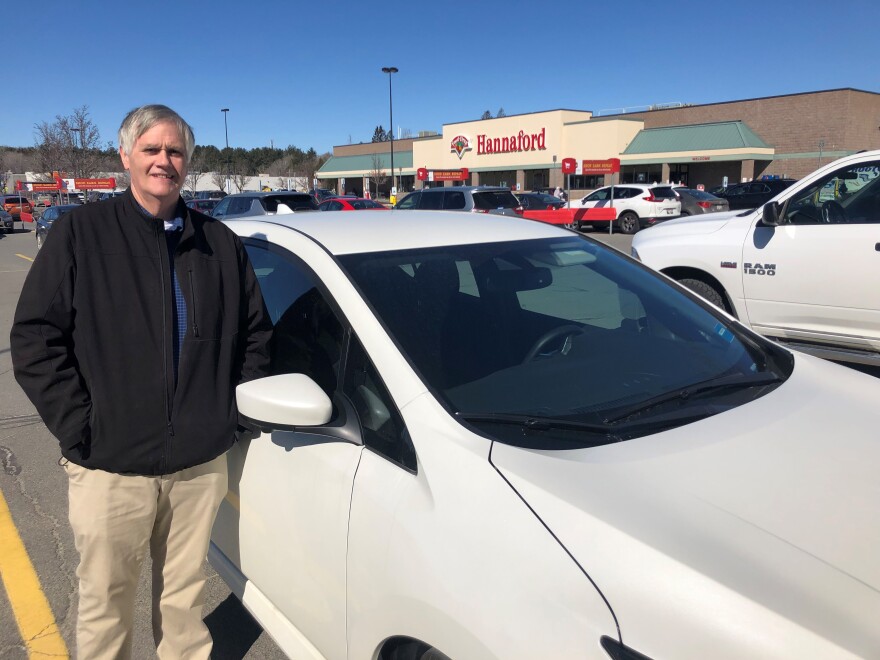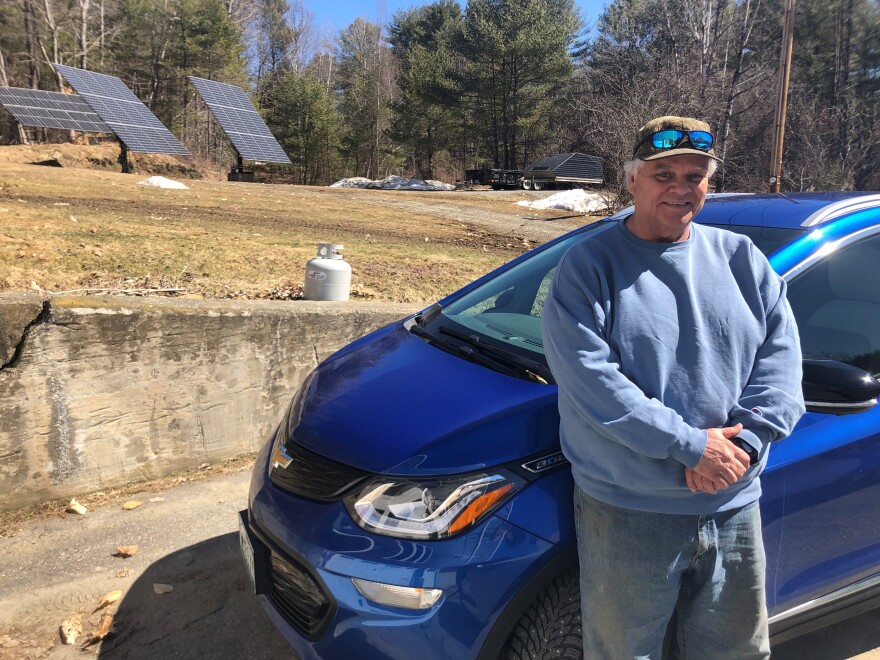Can you get there from here in Maine during wintertime? We put our electric vehicle to the test

“Gassing up” Maine Public’s electric vehicle, Pearl, in Jackman, Maine. (Patty Wight/ Maine Public)
Can you get there from here in Maine with a EV?
That’s what Maine Public staff have tried to do while reporting on recent stories for Climate Driven. The main takeaway? EV drivers need to use extra care planning their trips outside of southern Maine, where most of the chargers are.
Deputy News Director Susan Sharon drove Maine Public’s electric vehicle, a Nissan Leaf we’ve nicknamed Pearl, on a trip from Lewiston to Rangeley in February, but she ran into problems. First was the low temperatures that day, which can deplete EV batteries as much as 40%.
“So here’s the situation,” Susan said on a phone call from the road. “It’s very cold out. It’s between one and minus seven degrees, and I’ve made it to Farmington on my way to Rangeley. But the car is down to 68%.”
Click here to listen to the audio version of this story.
Susan tried to charge Pearl in Farmington, Maine, but couldn’t because of technical difficulties. And then an accident scene forced her to take a detour, which added too many miles.
“I have to cancel my plans for the day and try again on another day,” she said in a follow-up call.
This is the drawback to EVs right now. There are more than 500 public chargers in Maine, but most are in the southern part of the state. So doing a longer road trip north can feel risky.
“People really do have range anxiety,” says Joyce Taylor, chief engineer at the Maine Department of Transportation. “And they want to know, you know, ‘Even though I drive 95% of my miles in Cumberland County, occasionally I go see my aunt in Machias. And I really need to know I can get to Machias and back in my electric vehicle.'”
There are currently about 6,000 EVs on Maine’s roads, but the goal is to get to 219,000 by the end of the decade in order to help meet the state’s goal of cutting carbon emissions 45% by 2030.
Taylor says installing more charging stations will make a big difference in people’s willingness to go electric. And Michael Stoddard, executive director of Efficiency Maine, says President Joe Biden’s EV infrastructure plan, which will funnel $19 million into Maine to add more charging stations over the next five years, is a significant step forward.
“It’s going to provide enough budget that we can afford to put high-speed chargers every 50 miles from Fort Kent to Kittery,” he says. “And from Calais to the border with Quebec and all the major routes in between.”
The fast chargers, which can power batteries up to 80% in about half an hour, will be installed at easily accessible places, such as gas stations, grocery stores and universities. And that network of high-speed chargers will be supplemented with at least 500 Level 2 chargers, which power EV batteries in a few hours. Those will be in community parking lots and businesses.
The challenge, Stoddard says, will be to convince businesses to install chargers, because the federal funds only cover 80% of the cost.
“You’re asking people to invest in equipment to provide a service that is not yet needed by very many people,” Stoddard says. “You’re asking them to get ahead of a market that is coming, but isn’t here yet.”

Jeff Hewett, director of economic and community development in Skowhegan, Maine. (Patty Wight / Maine Public)
For Jeff Hewett, the hope is, “If you build it, they will come.” Hewett is the director of economic and community development in Skowhegan, which installed a Level 2 charger at the Chamber of Commerce a couple years ago.
Hewett says, so far, it isn’t getting much attention.
“In town, it is definitely slow,” he says.
There’s also a bank of chargers at the local Hannaford, which Hewett says are used a bit more. Still, he is optimistic that this part of Somerset County will be a destination for travelers from Canada and elsewhere, many of whom drive electric vehicles.
“We’re trying to attract people who really want to take advantage of the environment. And every year, we grow a little bit more that way,” he says.
I talk to Hewett at the charging station at Hannaford on my way up to Jackman. I drove Pearl here from the Maine Public studios in Lewiston to see what it’s like to travel with an EV in Somerset County, which only has a few charging stations.
By the time I make the roughly hourlong drive, Pearl’s battery is down 50% and 100 miles of range, even though I had only driven 70 miles.
I used up a lot more than the miles that it actually took to drive to Skowhegan, likely because it was cold out, around 30 degrees, and I also did a lot of highway driving, which is less efficient.
After an hour of charging, Pearl is at nearly 100%, so I’m ready to head to Jackman. But I take a slight detour to Norridgewock, where Bob Morrison lives. He has been driving electric cars for nearly a decade, and currently has a Chevy Bolt. I wanted to know how he’s been able to manage that in such a rural area.

Bob Morrison of Norridgewock, Maine, with his Chevy Bolt. (Patty Wight/ Maine Public)
“The newer ones, I mean, the Chevy Bolt is a 300-mile car in the summer for me,” he says. “So I’ve been to Portland and back and never charged and I still had enough to drive to my camp 45 more miles. So you know, it’s the new ones are a lot better, they have a bigger battery, bigger capacity.”
Morrison says some of the earlier model EVs could only go 100 miles, and he had to skip certain shopping trips in the winter because his battery wouldn’t make it. But he says he’s never run out of power, and he’ll be an EV driver for life.
“I can sum it up in a few words,” he says. “I’ll never drive gas again, ever.”
Morrison predicts that I’ll use about half of Pearl’s battery by the time I get to Jackman. Seventy miles later, his prediction is true. So I plug Pearl in at a bank of chargers at the Trailside One Stop gas station.
Within an hour, Pearl is charged 96% and it’s time to head back to Lewiston. Two and a half hours and 150 miles later, I pull Pearl into Maine Public’s parking lot with 64 miles of range left on the battery and about 30% power.
I made it back to Lewiston from Jackman, no problem. This trip in an EV was relatively easy because there were enough fast charging stations on my route. And next year, it should start to become easier across Maine. That’s when the installation of federally-funded chargers is expected to begin.
This story is part of Maine Public’s series “Climate Driven: A deep dive into Maine’s response, one county at a time.”
